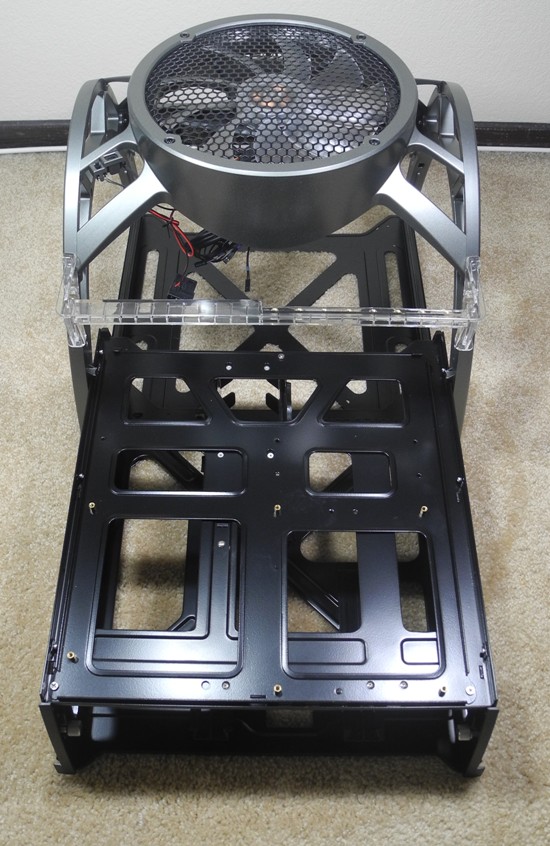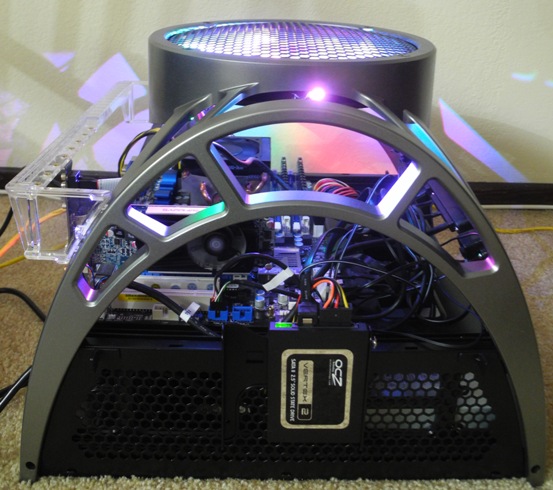AMD A8-3850 : An HTPC Perspective
by Ganesh T S on June 30, 2011 6:20 AM EST
AMD provided us with an A8-3850 CPU and an ASRock A75Pro4 ATX motherboard for the review. Purists might balk at the idea of a 100W TDP processor being used in tests intended to test the HTPC capabilities. However, we have to make do with whatever sample was sent to us. A look at the Lynx lineup indicates that the same product with a 2.6 GHz core clock (A8-3800) has a 65W TDP. I intended to underclock the CPU to 2.6 GHz. However, Llano clock adjustments are a minefield, as Ian points out in his ASRock Extreme6 review. The idle power usage in my testbed was good enough (as we shall see in a later section). My time was better spent debugging the HTPC related issues, and therefore, I didn't take the trouble to underclock.
As soon as I finished setting up the testbed, I found that Blu-rays would play correctly, but local file playback had a host of issues. Noise reduction and cadence detection wouldn't get activated for local files with ESVP on. Turning it off resulted in dropped frames and high load on the GPU. It was turning out to be very similar to the DDR3 based MSI 6450 we had reviewed earlier.
Being a new platform, BIOS updates for the ASRock A75 Pro4 were flying thick and fast. To confound the issue, different BIOS versions had different behaviors with the default UEFI settings. With some BIOS versions, even Blu-ray playback had the same issues as local files.
After going back and forth with AMD about the local file playback issue, we discovered that the BR softwares use a proprietary API for video playback from discs with DRM. For local file playback, most players use the DXVA API. These are different code paths and may result in different GPU utilization numbers.
Couple of days back, AMD finally discovered that the BIOS was forcing the shared GPU memory to an absurdly low value. The GFX memory settings forced by the user in the BIOS were also not honored. There was an update to the BIOS to fix this and set the default GFX memory to 512 MB. After this, both Blu-ray and local file playback improved enough for us to be able to get down to exhaustive testing. AMD did acknowledge that there exists an issue with local file playback having higher than normal GPU utilization, but that hasn't been resolved as yet.
The table below lists the components in our Llano HTPC testbed.
| AMD Llano HTPC Testbed Setup | |
| Processor | AMD A8-3850 - 2.90GHz, 4MB Cache (1MB/core) |
| Motherboard | ASRock A75Pro4 ATX |
| OS Drive | OCZ Vertex 2 120 GB |
| Memory | G.Skill Ripjaws Series 4GB (2 x 2GB) SDRAM DDR3 1333 (PC3 10666) F3-10666CL7D-4GBRH CAS 7-7-7-21 |
| Video Cards | None / Sapphire DDR3 6570 (for Crossfire) |
| Optical Drives | ASUS 8X Blu-ray Drive Model BC-08B1ST |
| Case | Antec Skeleton ATX Open Air Case |
| Power Supply | Antec VP-450 450W ATX |
| Operating System | Windows 7 Ultimate x64 |
| Display / AVR | Acer H243H / Onkyo TX-SR 606 + Toshiba Regza 37RV530U |
| . | |
The most important part of the testbed from a reviewer's perspective was the open air case from Antec. I had used the Antec VERIS Fusion MAX for the NAS / Fall 2010 HTPC testbed. The case was a HTPC beauty, and kept my lab neat and orderly (instead of having components all over the table and the floor). However, the fact that I had to open the case to swap PCI-E cards in and out made it slightly impractical.
The Antec Skeleton is a full ATX open air enclosure, and what really sealed the deal for me was the fact that the motherboard was easily accessible, and upto 4 SATA drives could be mounted on the side. It also has support for upto three 11" PCI-E cards. There are Quick Relase 5.25" and 3.5" bays, but I chose to mount only one optical drive in the 5.25" bay, leaving the rest open to route the cables. The four externally mounted 3.5" bays can also be used to mount 2.5" drives, as I did with the OCZ Vertex 2 SSD in the gallery below.
I keep moving my testbeds back and forth between the home theater setup with the bitstreaming / 24 Hz capable gear and the test lab upstairs with the ordinary monitors (so as to not disturb my family's usage of the HT gear). In the Antec Skeleton case, the grips on the top railing (on either side of the top fan) can be used as handles. This makes it very easy to carry around.
The fancy LED lights on top around the huge fan make it look very attractive and it is sure to turn heads.
The last thing was from an OC / gaming enthusiast viewpoint and not really from a reviewer's perspective!
Let us now proceed to the actual HTPC benchmarking of the Llano.


















104 Comments
View All Comments
ckryan - Thursday, June 30, 2011 - link
There's lots of good stuff to do with a GPU that doesn't involve games; unfortunately, it seems like that is the only thing AMD had in mind for the Llano GPU. It's unfortunate, since running a discrete GPU with Llano in its desktop form just seems to make Llano pointless. In a laptop you at least get decent game performance at low screen resolutions.My enthusiasm for the future of Llano isn't diminished, but strangely, it seems that Llano makes a cheap Phenom II + dGPU seem like a much better idea than it was yesterday.
Still, with some Bulldozer cores, improved GPU section, and some better drivers will go a long way to making Llano mainstream vs. a super-niche product for the desktop.
duploxxx - Thursday, June 30, 2011 - link
a super niche product for the desktop..... did you ever went to any large electronic shop? it's full of these kind of designs that you brand "niche". Check few OEM very soon they will all bulk this kind of Liano setups.... just like Brazos was a success this will also and already a major reason why intel introduces the 2105 just at release of Liano.... but the HD3000 over HD2000 remains crap.L. - Thursday, June 30, 2011 - link
You don't get it, the guy above is right !!!It's a super-niche product, for the biggest niche there is in the whole consumer market, normal people.
Gee AMD ... bad idea really ;)
Ananke - Thursday, June 30, 2011 - link
:) Llano is exactly what the mass-consumer grade computer market uses and needs. That's 99.5% of the total market. The other negligible 0.5% is enthusiast market, where most of the AnandTech readers belong. Intel is still king there.therealnickdanger - Thursday, June 30, 2011 - link
"However, this leads to increased expectations like support for full post processing on Blu-ray videos."Did I misunderstand the comment?
Assuming a faithful transfer from film (16mm/35mm/65/70mm) to Blu-ray (1080p24), there should be absolutely no reason to apply any post-processing to a Blu-ray. The worst transfers are those cases where the studio applied processing prior to encoding on the Blu-ray, and then there is no recourse to undo the effects. With only a handful of examples of low-budget or foreign films, there are no interlaced Blu-rays. And then, you would only need deinterlacing, not post-processing. Any artificial sharpening, coloring, or smoothing will ultimately degrade picture quality, not improve it. Outside of playing back Blu-rays in the proper color space and eliminating judder, not much else should be done to them.
ganeshts - Thursday, June 30, 2011 - link
Sorry if I wasn't clear in this respect. I had also mentioned in the HQV section that we believe Blu-rays don't need post processing.First, there are a lot more interlaced Blu-rays than we would actually expect. Loads of nature documentaries and concerts are available in 1080i60. While the former ones are mostly VC-1, the latter Blu-rays are all H.264
AMD's main stance with respect to not supporting 1080p60 camcorders was the fact that they want to target the Blu-ray market mainly. Now, 1080i60 is less demanding than 1080p60, and is also present in many camcorders which are already in the $200 - $300 range. If Llano GPUs don't support post processing on 1080i60 fully, I think it is a long way off before they start supporting 1080p60 decode along with post processing. So, the 'even for Blu-rays' comment is meant to stress that aspect rather than mean that we actually need the post processing for Blu-ray videos. (Local files were the main target of my post processing tests)
therealnickdanger - Thursday, June 30, 2011 - link
Understood, thanks for taking the time to respond!StormyParis - Thursday, June 30, 2011 - link
for a very detailed review. I don't know much about HTPCs to start with, and I'm left a bit overwhelmed and confused, though.First, I really don't think the current Llano is meant to be used with a discrete graphics card. I think the whole point of the product, and the only situation in which it's worth coping with their underpowered CPU / higher power draw, is if I actually take advantage of their GPU.
Second, I'm not really clear which issues are fixable in software, and which will stay. Actually, I'm not really clear which issues are important, and which aren't.
Third, It'd be nice to have a hint about what lower clocks / core counts will do. I'd rather use 65W parts for small enclosures, and I have the feeling that wouldn't change much, but I'm not sure.
geniekid - Thursday, June 30, 2011 - link
Sounds to me like, if they fixed their software issues, AMD would be the preferred platform for HTPC.ganeshts - Thursday, June 30, 2011 - link
Yes, let us wait and watch for a couple of driver releases